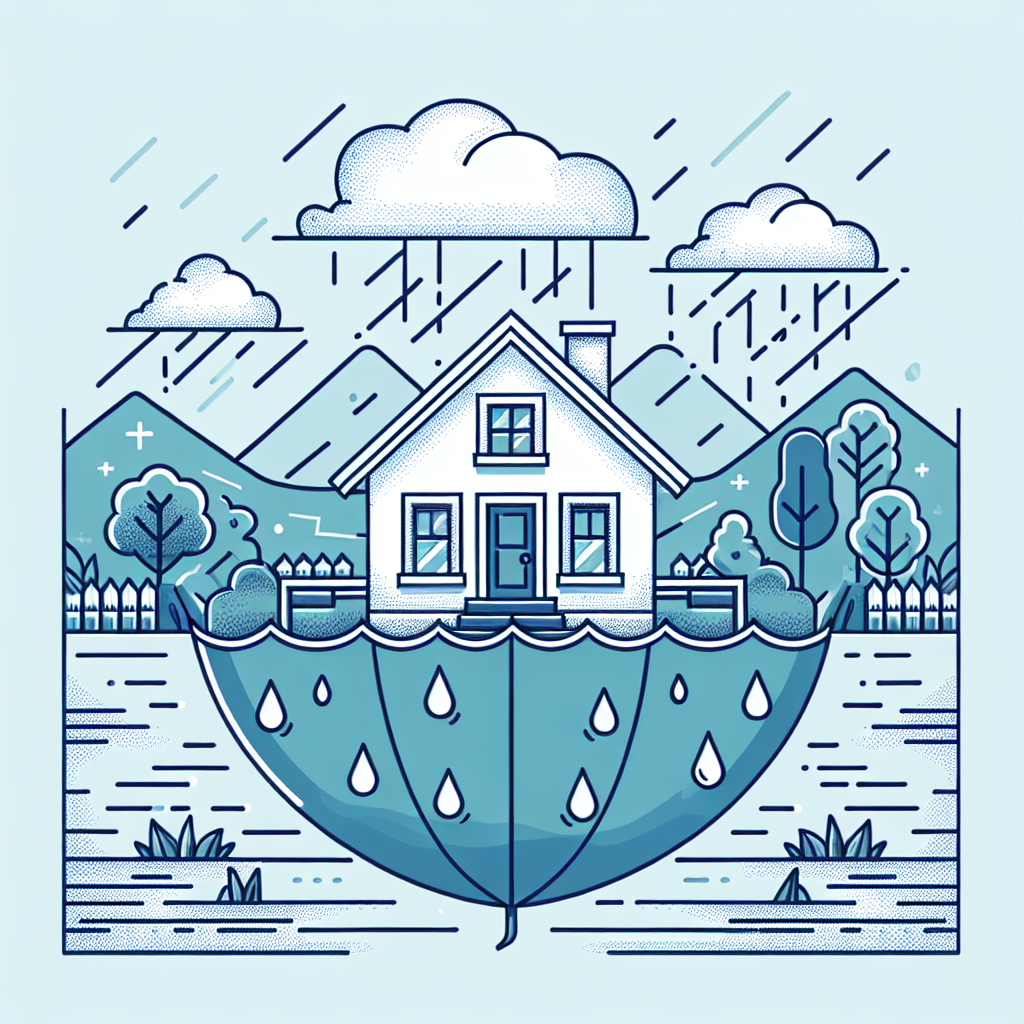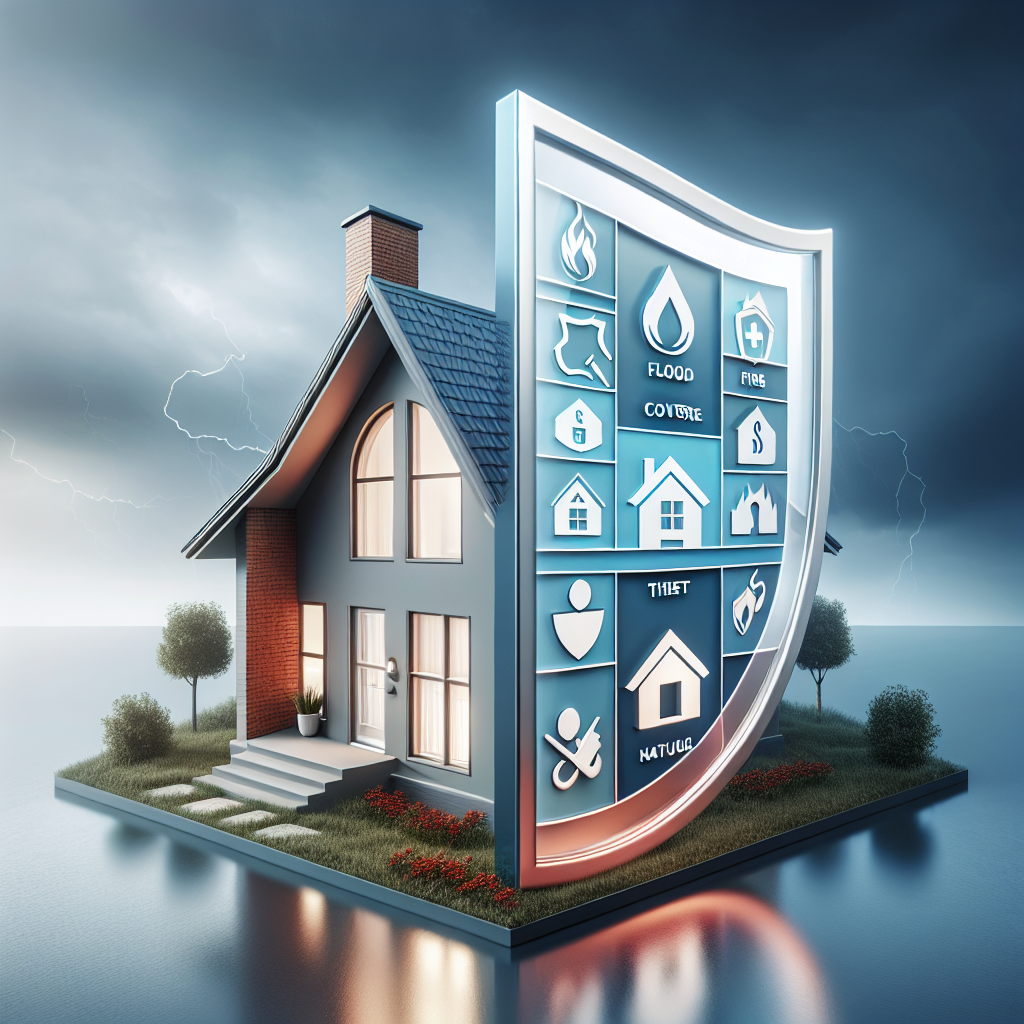Filed under Home Insurance on
Water Coverage Home Insurance Guide for Homeowners

Water damage is one of the most frequent and expensive threats to a home, yet it remains one of the most misunderstood. From burst pipes and storm-driven rain to sewer backups and floods, not all water losses are treated the same by insurers. This Water Coverage Home Insurance Guide for Homeowners untangles what’s covered, what isn’t, and how to build a protection plan that actually fits your property and risk profile.
Water Coverage Home Insurance Guide for Homeowners: The Big Picture
Standard homeowners policies are designed to cover sudden and accidental water damage that originates inside the home, like a burst supply line or a leaking water heater. However, they typically exclude external water sources such as overland flooding and storm surge, which require separate flood insurance. In between those two extremes are gray areas—like sewer or sump pump backups and long-term seepage—where coverage depends on how your policy is written and which endorsements you buy.
Industry data underscores the stakes. Insurance research frequently ranks water damage and freezing among the most common home claims, with average payouts often exceeding $10,000. Federal emergency data shows that nearly every U.S. county has experienced flooding in recent decades, and even one inch of water in a home can cause tens of thousands of dollars in damage. As climate patterns shift and infrastructure ages, frequency and severity for water-related losses are trending upward.
What Your Home Policy Typically Covers (and Why)
Most HO-3 (special form) and HO-5 (comprehensive) policies cover “sudden and accidental” water damage caused by events like a burst pipe, an appliance failure, or an overflowing AC condensate pan. The key concepts are sudden, accidental, and originating from within the building or a plumbing, heating, air conditioning, or fire sprinkler system.
When a covered water event happens, the policy can respond in multiple ways:
• Dwelling coverage (Coverage A) addresses structural damage such as ruined drywall, warped floors, or damaged cabinetry.
• Other structures (Coverage B) applies to detached garages, sheds, or fences impacted by a covered water event.
• Personal property (Coverage C) helps repair or replace belongings, ideally at replacement cost if you selected that option.
• Loss of use (Coverage D), often referred to as Additional Living Expense (ALE), helps pay for temporary housing and increased living costs while your home is repaired after a covered loss.
Sudden and Accidental vs. Maintenance
Insurers are careful to distinguish accidental water damage from maintenance issues. A pipe that bursts suddenly due to freezing is a classic covered scenario. Slow leaks from worn-out caulking, failed grout, or long-term seepage behind a shower enclosure are usually excluded because they result from wear and tear or neglect. Some carriers offer “hidden or unknown leakage” endorsements that extend coverage when a leak persisted beyond a certain number of days, but only when you buy that option and meet the specified conditions.
Common Water Damage Scenarios
• Burst or frozen pipes: Frequently covered if you maintained reasonable heat in the home.
• Appliance failures: A sudden washing machine hose rupture or dishwasher failure is generally covered; replacing the failed appliance part itself is not.
• HVAC condensate overflows: Often covered when sudden and accidental.
• Roof leaks from wind-driven rain: Coverage depends on whether wind damage created an opening. Rain entering through an existing maintenance issue may be excluded.
• Sewer or drain backup: Typically excluded unless you add a specific endorsement with its own limit (for example, $5,000 to $25,000 or more).
• Sump pump overflow: Often excluded unless endorsed; coverage limits vary.
• Overland flooding, storm surge, and mudflow: Excluded by homeowners insurance; covered under flood insurance (NFIP or private markets).
• Groundwater or seepage through foundations: Generally excluded as a maintenance or flood-related issue.
• Mold: Commonly limited by sublimits unless you buy increased mold coverage.
Exclusions and Gray Areas You Must Understand
Policy exclusions are not fine print you can ignore—they are the roadmap for what you’ll pay out-of-pocket. In many forms, an anti-concurrent causation (ACC) clause can exclude a loss if any excluded peril contributes to the damage, even if a covered peril is also involved. For example, if a flood event and a plumbing failure both contribute to a loss, the flood exclusion could void coverage under the homeowners policy unless your policy specifically carves out an exception.
Key exclusions and restrictions to review carefully include:
• Flood and surface water: Requires separate flood insurance; not covered under standard homeowners policies.
• Sewer, drain, or sump backups: Usually excluded unless you add the endorsement; the endorsement typically has a separate sublimit.
• Long-term leakage, rot, and deterioration: Wear and tear, neglect, and repeated seepage are typically excluded.
• Foundation and slab leaks: Coverage varies; repairs to access the plumbing may be covered, but the cost to replace pipes or structural elements can be limited without the right endorsements.
• Mold and fungi: Often limited to modest sublimits unless you opt for higher mold coverage.
To make informed decisions, revisit your declarations page, read the water and mold sections of your policy, and ask your agent about endorsements. The best Water Coverage Home Insurance Guide for Homeowners emphasizes exclusions first, so you can close gaps before they become costly surprises.
Endorsements and Add-On Policies That Fill the Gaps
While the base policy handles sudden and accidental internal water damage, several endorsements and separate policies shore up the most common holes:
• Water backup and sump overflow endorsement: Adds coverage for backups from sewers or drains or sump pump overflows. Limits often range from $5,000 to $50,000. Choose a limit that matches your basement finish and mechanical systems exposure.
• Hidden or unknown leak coverage: Some insurers offer protection for long-term, hidden leaks discovered after weeks or months. The coverage scope and time threshold vary widely by carrier.
• Service line coverage: Extends to underground utility lines you own, including water and sewer lines from the street to the house. This can help with excavation and repair costs that are usually excluded.
• Mold, fungi, and bacteria buy-up: Increases mold remediation limits. Given rising remediation costs, many homeowners upgrade beyond baseline sublimits.
• Equipment breakdown: Covers sudden mechanical breakdowns of systems like HVAC or well pumps; not a water coverage per se but can mitigate related costs.
• Flood insurance (NFIP or private): Essential for overland flood, storm surge, and mudflow. NFIP policies cap building coverage at $250,000 for single-family homes and contents at $100,000; private carriers may offer higher limits, additional living expenses, and broader terms. Choice depends on your flood zone, home value, and risk tolerance.
• Ordinance or law coverage: Pays for code upgrades required during reconstruction after a covered loss. This can be vital if water damage triggers mandatory retrofit requirements.
Your Water Coverage Home Insurance Guide for Homeowners checklist should include these add-ons as standard review items during renewal, with limits calibrated to your property’s finish level and local risk.
How Deductibles and Limits Shape Your Outcome
All-peril deductibles usually apply to water claims under the homeowners policy. Some policies also include separate deductibles for wind/hail or hurricanes; these typically do not apply to purely internal water losses, but read your policy closely. For sewer backup endorsements, a separate deductible may apply. For flood insurance, the NFIP lets you choose separate building and contents deductibles, and private flood policies may offer more flexibility.
Choosing a higher deductible can reduce premiums, but ensure your emergency fund can comfortably cover it. At the same time, verify that your dwelling limit reflects true replacement cost—rising material and labor prices can quickly exhaust underinsured limits, especially when water damage requires extensive tear-out and mold remediation.
Policy Forms: HO-3 vs. HO-5 and Why It Matters
HO-3 policies are “open peril” for the dwelling but “named peril” for personal property. HO-5 forms are generally “open peril” for both, which can broaden coverage for personal property damaged by sudden water events, subject to exclusions. HO-5 forms may also come with higher baseline sublimits and more favorable terms for special situations. Even with an HO-5, however, external flood remains excluded unless you add flood insurance.
Regional Risk and Pricing Trends
Water risk varies by geography, building age, and infrastructure:
• Coastal regions face storm surge, king tides, and tropical rainfall events that can overwhelm drainage.
• Inland communities see riverine flooding, flash floods, and “atmospheric river” rain events.
• Snowbelt states contend with freeze-related pipe bursts and ice dams, especially in under-insulated homes.
• Urban cores experience sewer backups due to older combined sewer systems and heavier downpours.
• Wildfire burn scars increase mudflow and debris flow risks during subsequent storms.
Flood insurance pricing has also evolved. Public programs have moved toward risk-based pricing, while private flood markets are expanding with flexible coverage terms. The right option depends on your elevation, distance to water, drainage, and the structure’s replacement cost. A practical Water Coverage Home Insurance Guide for Homeowners will factor local building codes, soil types, and neighborhood drainage into your decision-making.
What to Do When Water Strikes: A Claim Roadmap
Speed and documentation are your allies. Here is a process that aligns with common policy requirements and industry standards for water mitigation:
• Protect people first. If there’s electrical hazard or structural danger, evacuate and call professionals.
• Stop the source. Shut off the main water supply; for appliance leaks, cut power and water to the unit.
• Prevent further damage. Move items off wet floors, place foil under furniture legs, and start ventilation if safe.
• Document everything. Take time-stamped photos and videos of the source, affected areas, and damaged items. Keep receipts for emergency expenses.
• Notify your insurer quickly. Ask about approved vendors for mitigation to avoid disputes later. Many carriers have preferred mitigation contractors who follow IICRC S500 standards for drying and remediation.
• Preserve evidence. Do not discard damaged components (like burst hoses) until the adjuster has inspected them; they may be needed for subrogation.
• Get estimates. Secure detailed, line-item estimates that include tear-out, drying equipment, reconstruction, and any required code upgrades.
• Use ALE benefits appropriately. Keep meticulous records of temporary housing and meal expenses if your home is uninhabitable.
• Beware broad assignments of benefits. Some contracts transfer your claim rights; consult your insurer or a trusted advisor before signing.
For flood claims, additional rules apply, including filing a Proof of Loss within a prescribed timeline. Confirm deadlines early to avoid inadvertent forfeiture.
Prevention Pays: Practical Steps and Possible Discounts
Every dollar spent on prevention can save multiples in losses and hassle. Many insurers now incentivize risk reduction with device credits or premium discounts.
High-impact measures include:
• Install an automatic water shutoff valve with flow monitoring. These systems can detect anomalies and shut off water before damage escalates.
• Add leak sensors under sinks, near water heaters, dishwashers, refrigerators with ice-makers, and in basements near sumps.
• Insulate exposed pipes and maintain indoor temperatures above freezing during cold snaps; open cabinet doors to circulate warm air.
• Replace rubber washing machine hoses with braided stainless steel; consider replacing supply lines during any renovation.
• Service and replace water heaters proactively (often every 8–12 years, depending on type and water quality) and use a drain pan with a plumbed drain where feasible.
• Install a battery or water-powered backup for your sump pump; test it before storm seasons.
• Consider a backwater valve to prevent municipal sewer backups where permitted by code.
• Maintain your roof: clear debris, seal penetrations, and clean gutters and downspouts; extend downspouts several feet from the foundation and ensure the grading slopes away from the home.
• Seal foundation cracks and consider perimeter drains or French drains if groundwater is a recurring issue.
• Keep a detailed home inventory with photos for smoother contents claims.
Ask your carrier about available discounts for monitored shutoff systems and certified mitigation upgrades. Insurers report markedly fewer and smaller losses when technology catches leaks early.
Budgeting and What Coverage Usually Costs
Premiums vary widely by state, carrier, claims history, construction type, distance to water, and local loss patterns. As a directional guide:
• Water backup endorsements can range from modest annual costs for small limits to a few hundred dollars for higher limits, depending on your market and risk.
• Flood insurance through public programs can range from a few hundred dollars in low-risk zones to several thousand in high-risk coastal areas; private flood options can be competitive for many homes and may offer broader features like additional living expenses.
• Smart water shutoff credits and other mitigation discounts can offset part of the added premium for endorsements.
Remember claim impacts. A water claim can affect renewal pricing and availability. When feasible, evaluate the cost-benefit of paying smaller losses out-of-pocket to preserve favorable pricing—balanced against your policy conditions and deadlines for reporting losses.
Questions to Ask Your Agent or Broker
• What are my water-specific exclusions, sublimits, and waiting periods?
• Do I have sewer or sump backup coverage, and at what limit and deductible?
• Is hidden or unknown leakage coverage available, and how is “hidden” defined?
• Are my dwelling and personal property covered at replacement cost or actual cash value?
• What mold remediation limit applies, and can I buy more?
• Is service line coverage available for my water and sewer laterals?
• Which mitigation devices earn credits (leak sensors, automatic shutoff valves)?
• Should I switch to an HO-5 form for broader personal property protection?
• What flood options—public or private—fit my home’s elevation and replacement cost?
• Are there separate perils or percentage deductibles that could apply to water-related events?
Common Myths, Debunked
Myth: “If water damaged it, insurance pays for it.” Reality: Source and cause matter. Internal, sudden, and accidental is the usual trigger; external flood requires separate coverage; backups and long-term seepage are often excluded without endorsements.
Myth: “I’m outside a high-risk flood zone, so I don’t need flood insurance.” Reality: A notable share of flood claims occur outside designated high-risk areas, often after intense localized storms.
Myth: “My homeowners policy covers sewer backups.” Reality: Not unless you add the endorsement—and even then, check the sublimit and deductible.
Myth: “Mold remediation is fully covered.” Reality: Mold is typically sublimited unless you buy additional coverage, and policies often require prompt mitigation to remain eligible.
A Simple, Actionable Checklist
• Audit: Read your policy’s water, mold, and exclusions sections; note sublimits and deductibles.
• Endorse: Add water backup/sump overflow, hidden leak (if available), service line, and increased mold limits as needed.
• Flood: Price both public and private flood insurance; align building and contents limits with replacement cost and your inventory.
• Fortify: Install leak sensors and an automatic shutoff; upgrade hoses; insulate pipes; maintain your roof and drainage.
• Document: Create a home inventory and store it offsite or in the cloud.
• Review: Reassess limits annually, especially after renovations or local building cost spikes.
• Prepare: Know your main water shutoff location; keep a mitigation kit (fans, towels, plastic sheeting) ready; pre-vet reputable contractors.
How Insurers Evaluate Water Claims
Adjusters look for proximate cause: what exactly initiated the loss? They’ll differentiate between sudden failures and maintenance issues, check for prior related damage, and look at whether steps were taken to prevent further damage once the loss occurred. They may bring in experts—plumbers, roofers, engineers, or environmental hygienists—especially if mold, structural components, or code upgrades come into play.
Documentation and transparency go a long way. Provide service records for plumbing and HVAC, proof of temperature maintenance during winter, and any device logs from leak detection systems. These can help validate your claim and substantiate higher-quality repairs.
Bringing It All Together
Effective water risk management blends the right policy form, targeted endorsements, regional flood protection, and practical home improvements. With higher-intensity storms, aging building systems, and escalating rebuild costs, a set-it-and-forget-it approach is no longer sufficient. A living plan that you revisit annually—especially after renovations or local weather pattern shifts—delivers better outcomes and faster recoveries.
If you remember one thing from this Water Coverage Home Insurance Guide for Homeowners, let it be this: align coverage to cause. Internal sudden loss? Homeowners policy. Backups and hidden leaks? Endorsements. Overland flood or surge? Flood policy. Then add modern prevention technology to cut off losses before they spread.
Use this Water Coverage Home Insurance Guide for Homeowners as your baseline, then tailor it to your home’s location, construction, and systems. Ask detailed questions, compare carriers, and pressure-test your limits against real repair costs. In doing so, you’ll transform insurance from a commodity into a strategy—one that keeps your household dry, livable, and financially resilient when water finds a way in.
Finally, share this Water Coverage Home Insurance Guide for Homeowners with family members so everyone knows where the main shutoff is, how to respond to a leak, and whom to call. Preparation plus the right coverage is the formula for turning a bad day into a recoverable event.
Should you want a quick recap to discuss with your agent, tell them you’ve reviewed a Water Coverage Home Insurance Guide for Homeowners and want to confirm four points: flood coverage, endorsements (backup, hidden leak, mold), replacement cost coverage for building and contents, and the impact of mitigation devices on both risk and premium. That conversation alone can close most of the costly gaps.





